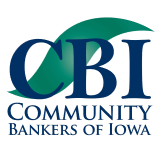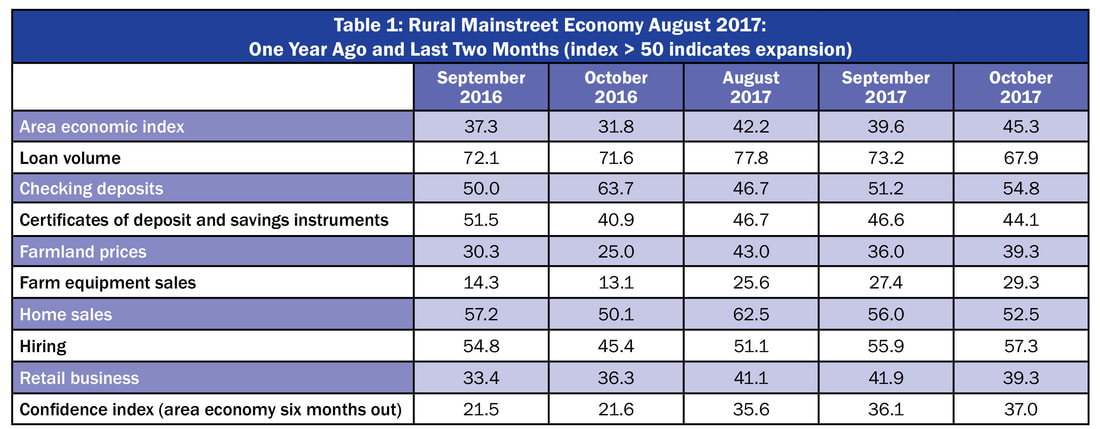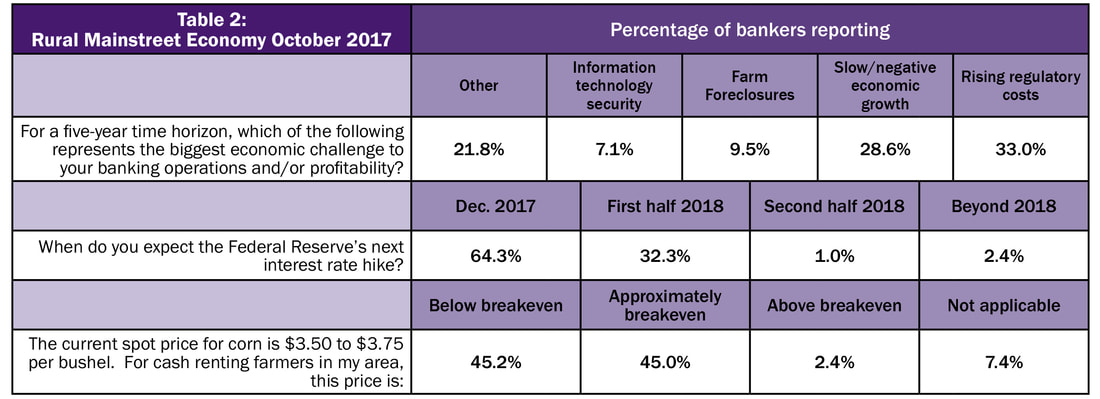- The overall index improved from September's reading, but remained below growth neutral.
- For the 47th straight month, average farmland prices declined across the 10-state region.
- For the 50th straight month, the agriculture equipment sales index fell below growth neutral.
- Almost one in 10 bankers expect farm foreclosures to be the greatest challenge to banking operations over the next five years.
- Almost one-half of bankers report that current corn prices are below break-even for cash renting farmers in their area.
Overall: The index, like all indices in the survey, ranges between 0 and 100, increased to 45.3 from 39.6 in September.
“As a result of weak farm income and low agriculture commodity prices, approximately 9.5 percent of bank CEOs expect farm loan foreclosures to pose the greatest threat to banking operations over the next five years,” said Ernie Goss, Jack A. MacAllister Chair in Regional Economics at Creighton University's Heider College of Business.
Farming and Ranching: The farmland and ranchland-price index for October slipped to 39.3 from 39.6 in September. This is the 47th straight month the index has fallen below growth neutral 50.0.
Bankers were asked to compare current spot prices for a bushel of corn to break even. Only 2.4 percent of bankers indicated that prices between $3.50 and $3.75 were above break even. Approximately 45.2 percent reported current spot prices were below break even.
However, Fritz Kuhlmeier, CEO of Citizens State Bank in Lena, Illinois, said, “Where can I find a spot price for corn of $3.50 or above today? Try $3.00 to $3.20, which is below the break even by all means.”
The October farm equipment-sales index increased to 29.3 from September’s 27.4. This marks the 50th consecutive month the reading has dropped below growth neutral 50.0.
Banking: Borrowing by farmers was strong for October as the loan-volume index fell to a still strong 67.9 from 73.2 in September. The checking-deposit index was 54.8, up from September’s 51.2, while the index for certificates of deposit and other savings instruments sank to 44.1 from 46.6 in September.
“Rural Mainstreet bankers have been generally supportive of Federal Reserve rate hikes.
Approximately, 64.3 percent anticipate one more 2017 rate increase,” said Goss.
Hiring: The employment gauge climbed to 57.3 from September’s 55.9. Rural Mainstreet businesses not linked to agriculture increased hiring for the month, and at a faster pace than in September.
Confidence: The confidence index, which reflects expectations for the economy six months out, increased to a weak 37.0 from 36.1 in September, indicating a continued pessimistic outlook among bankers. “Concerns about trade, especially current NAFTA negotiations, and low agriculture commodity prices impaired bankers’ economic outlook for the month,” said Goss.
Home and Retail Sales: The home-sales index moved lower for the Rural Mainstreet economy for October, falling to 52.5 from September’s 56.0. The October retail-sales index slumped to 39.3 from 41.9 in September. “Much like their urban counterparts, Rural Mainstreet retailers are experiencing significant pullbacks in sales,” reported Goss.
This survey represents an early snapshot of the economy of rural agriculturally and energy-dependent portions of the nation. The Rural Mainstreet Index (RMI) is a unique index covering 10 regional states, focusing on approximately 200 rural communities with an average population of 1,300. It gives the most current real-time analysis of the rural economy. Goss and Bill McQuillan, former chairman of the Independent Community Banks of America, created the monthly economic survey in 2005.
| Colorado: Colorado’s Rural Mainstreet Index (RMI) improved to 42.1 from 39.2 in September. The farmland and ranchland-price index expanded to 49.0 from September’s 35.7. Colorado’s hiring index for October climbed to 55.9 from September’s 54.6. Illinois: The October RMI for Illinois rose to 45.1 from 42.2 in September. The farmland-price index slumped to 35.1 from 35.9 in September. The state’s new-hiring index rose to 56.6 from last month’s 55.4. Jim Eckert, president of Anchor State Bank in Anchor, said, “Harvest is well underway here. Corn is yielding only 5-10 percent less than last year, which is much better than expected. Soybeans yields are 10-15 percent lower than last year.” Iowa: The October RMI for Iowa climbed to 45.6 from 39.9 in September. Iowa’s farmland-price index for October fell to 36.0 from September’s 36.2. Iowa’s new-hiring index for October slipped to 56.9 from September’s 57.5. James Brown, CEO of Hardin County Savings Bank in Eldora, said, “Yields on crops are somewhat better than expected so far. (There is) still a long way to go in harvest however.” Kansas: The Kansas RMI for October advanced to 42.2 from September’s 36.5. The state’s farmland-price index rose to 37.2 from 33.9 in September. The new-hiring index for Kansas increased to 43.6 from September’s 42.4. Minnesota: The October RMI for Minnesota advanced to 50.9 from 50.2 in September. Minnesota’s farmland-price index climbed to 39.6 from 36.3 in September. The new-hiring index for the state expanded to 59.7 from September’s 58.5. Pete Haddeland, CEO of the First National Bank in Mahnomen said, “Harvest has gone well in our area. Land values are holding.” | Missouri: The October RMI for Missouri slipped to 49.2 from 51.3 in September. The farmland-price index climbed to 40.9 from September’s 38.6. Missouri’s new-hiring index rose to a very healthy 74.7 from 73.4 in September. Nebraska: The Nebraska RMI for October expanded to 45.9 from 40.2 in September. The state’s farmland-price index jumped to 39.7 from last month’s 36.4. Nebraska’s new-hiring index stood at a strong 60.0, up from 58.8 in September. According to Jeffrey Gerhart, president and chairman of the Bank of Newman Grove in Newman Grove, “Prices and yields will continue to be a concern for those of us involved in agricultural lending. In the meantime we will continue to work with our borrowers to help them get through these tougher times.” North Dakota: The North Dakota RMI for October increased to 47.9 from September’s 42.2. The state’s farmland-price index moved to 41.0 from 37.7 in September. North Dakota’s new-hiring index dipped to 66.5 from 67.9 in September. South Dakota: The October RMI for South Dakota grew to 43.8 from 38.1 in September. The state’s farmland-price index expanded to a weak 38.3 from 35.0 in September. South Dakota's new-hiring index improved to 50.9 from September’s 49.7. Wyoming: The October RMI for Wyoming increased to 44.7 from September’s 39.0. The October farmland and ranchland-price index jumped to 38.3 from 35.6 in September. Wyoming’s new-hiring index advanced to 54.9 from September’s 53.7. |
(Click each table to view larger.)



 RSS Feed
RSS Feed